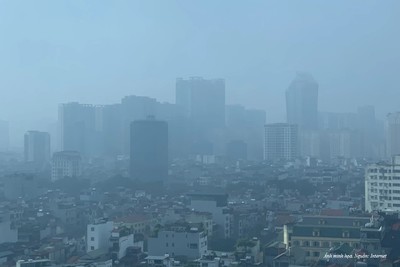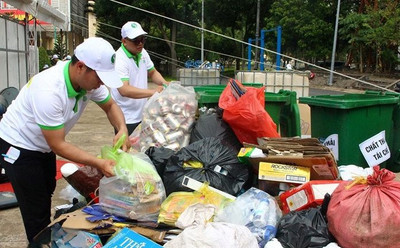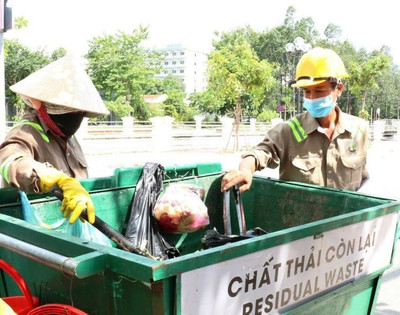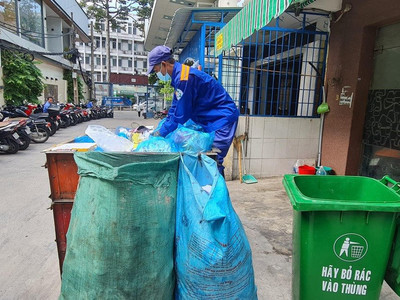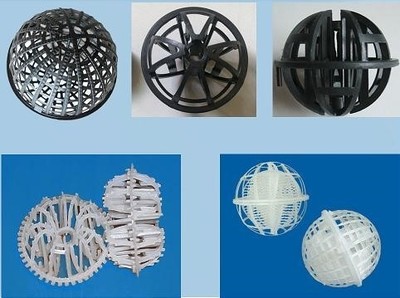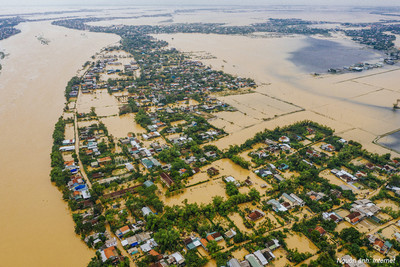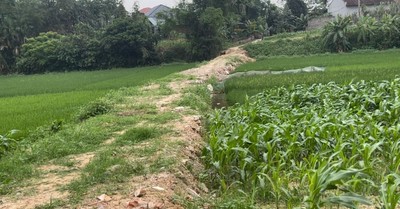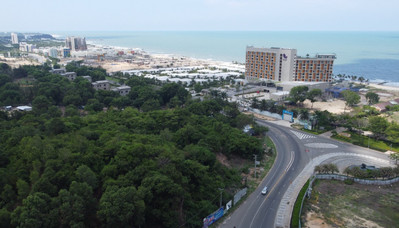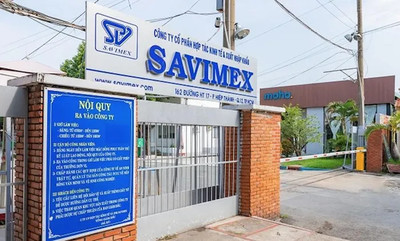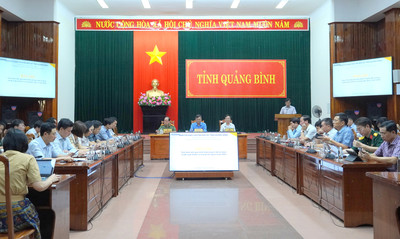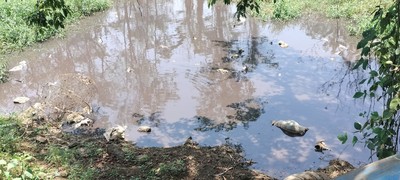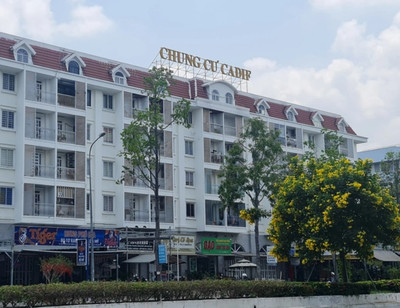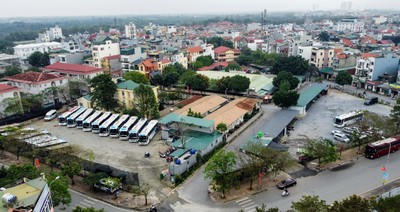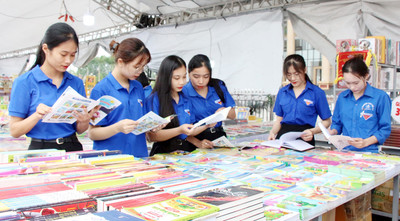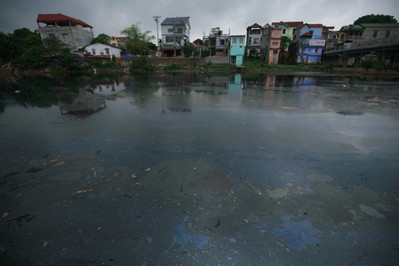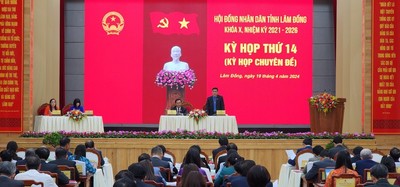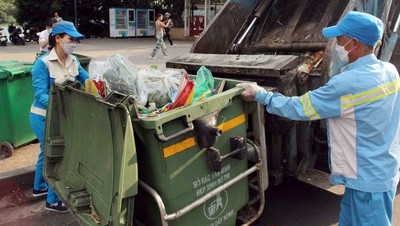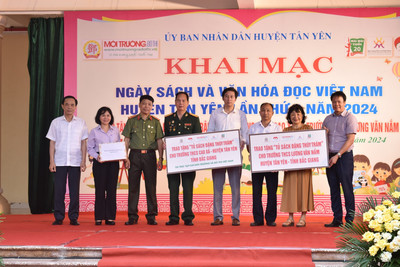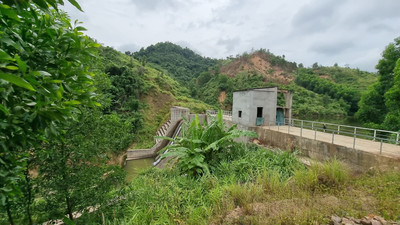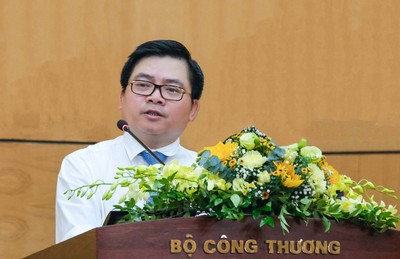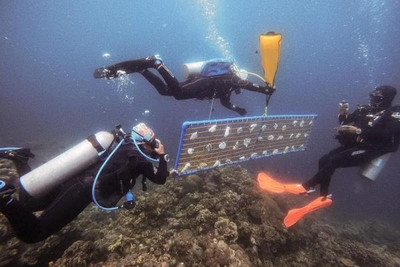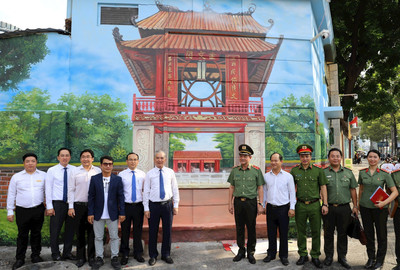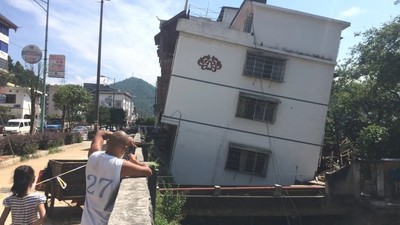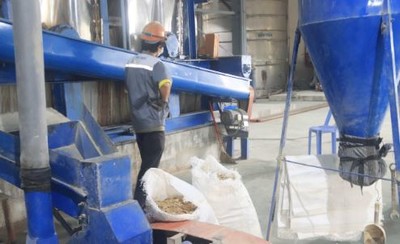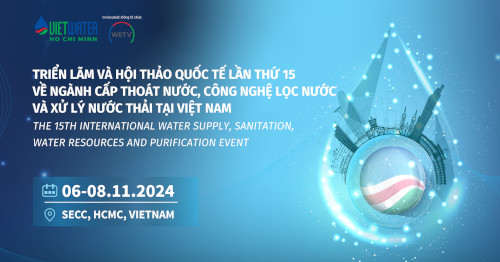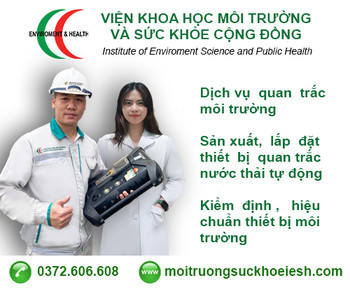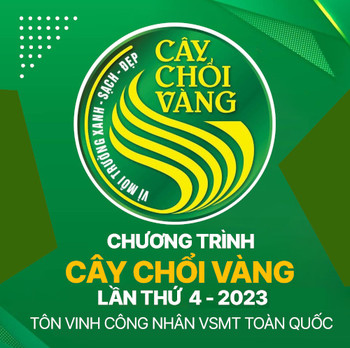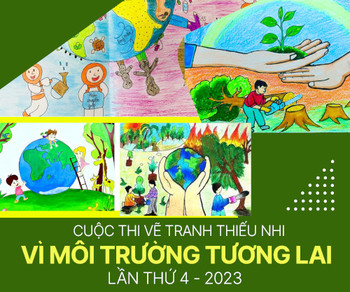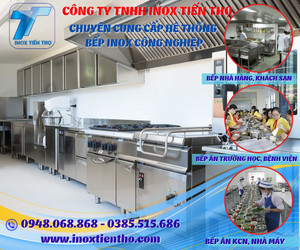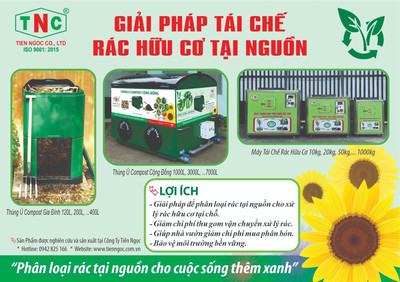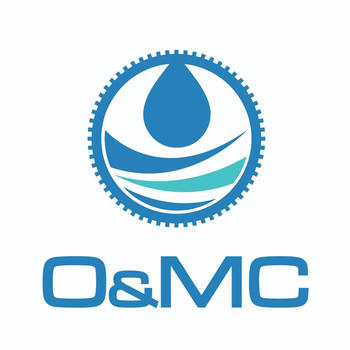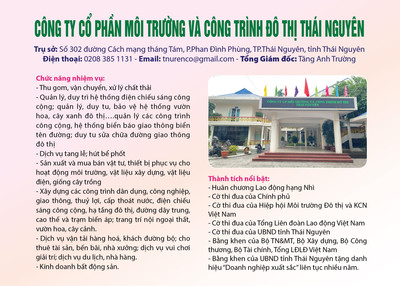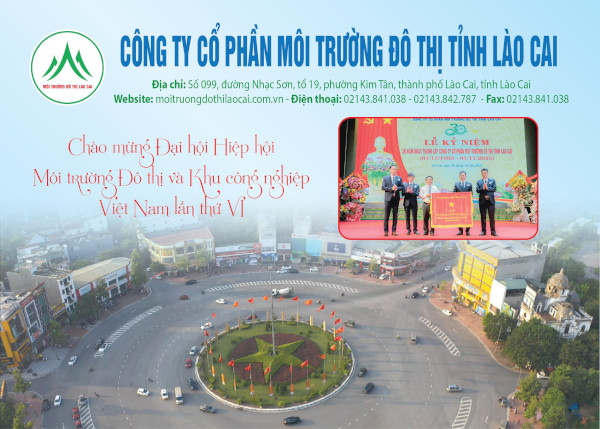Công bố quốc tế lĩnh vực môi trường số 46-2022
Chuyên trang Quản lý môi trường trân trọng giới thiệu tới quý độc giả Công bố quốc tế lĩnh vực môi trường số 46-2022 với những nội dung chính như sau:
Về quản lý môi trường
- Dự báo thay đổi sử dụng đất và đánh giá chất lượng môi trường sống bằng cách kết hợp các mô hình phát triển và biến đổi khí hậu
- Hiệu quả giảm phát thải tổng hợp của "Kế hoạch hành động kiểm soát và ngăn ngừa ô nhiễm không khí” của Trung Quốc: Lợi ích và hiệu quả
- Các yếu tố ảnh hưởng đến dấu chân sinh thái: Nghiên cứu về các nước OECD
- Ô nhiễm ozone mùa hè ở Trung Quốc bị ảnh hưởng bởi cường độ của các hệ thống gió mùa châu Á
- Khung đánh giá tác động môi trường định hướng tương lai của các công ty xem xét các Mục tiêu Dựa trên Khoa học
- Đánh giá sau khi sử dụng: Xác định và giảm thiểu các rào cản thực hiện để giảm tác động môi trường
- Các chiến lược kinh doanh để thay đổi mang tính chuyển đổi: Ứng dụng cho các phong trào cơ sở vì hệ thống nước đô thị bền vững
- Thực hành xanh và hiệu suất hoạt động: Vai trò điều tiết của sự nhanh nhẹn
- Đánh giá phân tách về an ninh nước quốc gia: Ứng dụng cho các lưu vực sông ở Thái Lan
- Quản lý thực vật nước thải dệt nhuộm để sản xuất khí sinh học kép và than sinh học: Một cách tiếp cận bền vững và kinh tế kỹ thuật
Về môi trường đô thị
- Tác động lâu dài của vận hành hydrocyclone đối với hình thái bùn hoạt tính và vận hành bể lắng thứ cấp quy mô đầy đủ trong điều kiện thời tiết ẩm ướt trong NMXLNT có tuổi bùn dài
- Đặc điểm phân bố của hạt vi nhựa trong các dòng sông đô thị ở thành phố Thành Đô: Ảnh hưởng của loại hình sử dụng đất và dân số và các đề xuất liên quan
- Bảo vệ bầu trời xanh ở các thành phố thí điểm carbon thấp: Viễn cảnh lan tỏa không gian về hiệu quả phát thải carbon
- Thăm dò dựa trên dữ liệu có hệ thống về xử lý nước thải và bùn thải của Áo - tác động đối với quản trị phốt pho, chi phí và môi trường
- Môi trường đô thị và hoạt động thể chất và khả năng ở bệnh nhân bệnh phổi tắc nghẽn mạn tính
- Các phân tích bộ gen so sánh của vi khuẩn và vi rút gây bệnh và gen kháng kháng sinh trong kênh giao thông đô thị
- Lò phản ứng tầng sôi sinh học ưa nhiệt trong dây chuyền bùn giảm phát thải khí nhà kính trong hệ thống xử lý nước thải
- Động lực tạm thời của bộ gen SARS-CoV-2 và phát hiện các biến thể đáng lo ngại trong nước thải đầu vào từ hai khu vực đô thị ở Arkansas
- Chính sách thí điểm thành phố carbon thấp ảnh hưởng như thế nào đến hiệu quả quản trị tổng hợp của carbon và khói bụi? Bằng chứng gần như thực nghiệm từ Trung Quốc
- Chuyển đổi hiệu quả sinh thái áp dụng cho quản lý chất thải rắn đô thị ở Amazon
- Hướng tới quản lý đô thị thông minh và bền vững: Một mô hình ra quyết định kỹ thuật mới có giá trị cho các dự án thoát nước
Về môi trường khu công nghiệp
- Hành vi phức tạp giữa vi nhựa và kháng sinh và ảnh hưởng của chúng đối với chủng Shewanella loại bỏ phốt pho trong quá trình xử lý nước thải
- Lựa chọn các giải pháp thay thế xử lý xanh cho các khu công nghiệp hóa chất: Đánh giá vòng đời tích hợp và phương pháp đánh giá tổng hợp mờ Chiến lược lai mới của quy trình Photo-Fered-Fenton được hỗ trợ bởi O3 để phân hủy nước thải từ quá trình tiền xử lý sản xuất dầu diesel sinh học
- Khám phá một con đường mới để giảm lượng khí thải gây ô nhiễm không khí trong nhà máy thiêu kết của nhà máy thép
- Chuẩn bị vật liệu bọt bền vững thông qua quá trình chuyển đổi khoáng chất nhắm mục tiêu ettringite của chất thải rắn công nghiệp
- Quá trình hóa rắn/ổn định kim loại nặng trong đất bằng chất thải công nghiệp có tính kiềm: Đánh giá quan trọng
- Lợi ích môi trường của việc tái cấu trúc ngành điện ở Trung Quốc: Kết hợp sở hữu so với tách nhóm theo chiều dọc
- Việc tạo ra một biên giới dầu mỏ: Động lực lãnh thổ hóa trong ngành công nghiệp dầu mỏ mới nổi của Uganda
- Phúc lành hay nguyền rủa? Quy định môi trường định hướng thị trường và năng suất nhân tố tổng hợp của doanh nghiệp——Bằng chứng từ các thí điểm thị trường carbon của Trung Quốc
- Khảo sát khả năng phân hủy của vi nhựa polyetylen trong quá trình phân hủy kỵ khí sử dụng nước thải công nghiệp mỹ phẩm
1. Spatiotemporal pattern of carbon productivity and carbon offset potential in Chinese counties
Science of The Total Environment, Volume 846, 10 November 2022, 157153
Abstract
This study used panel data for 2166 county-level units in China between 2000 and 2017 to characterize carbon productivity's temporal and spatial evolution in Chinese counties. The "catch-up effect” of carbon offsets between counties was examined, and this was used to measure the carbon offset potential and analyze its spatial differences. The results indicated that: (1) China's carbon productivity increased from 2000 to 2017; carbon productivity in eastern China was the highest, and carbon productivity in northeast China was the lowest. A polarization to unipolarization evolutionary trend was evident. (2) Considering the spatial differences in carbon productivity, the overall difference in carbon productivity in China from 2000 to 2017 first decreased and then increased; the contribution rate of differences between cities and counties to the overall difference was relatively stable, at around 39.88 %. The contribution rate of the differences between zones to the overall difference was the lowest, remaining stable at around 2.49 %. (3) In terms of the spatial distribution of the carbon offset potential, the eastern region exhibited the highest average carbon offset potential. The carbon offset potential of China exhibited a "high in the north and low in the south; low in the west and high in the east” spatial pattern.
2. Projections of land use change and habitat quality assessment by coupling climate change and development patterns
Science of The Total Environment, Volume 847, 15 November 2022, 157491
Abstract
Exploring future land use changes and assessing the habitat quality remains a challenging topic for watershed ecological sustainability. However, most studies ignore the effects of coupled climate change and development patterns. In this study, a framework for assessing habitat quality under the influence of future land use change is constructed based on exploring the driving forces of land use change factors and integrating the system dynamics (SD) model, future land use simulation (FLUS) model and InVest model. The framework enables the projection of land use change and the assessment of habitat quality in the context of future climate change and different development strategies. Applying the framework to the Weihe River Basin, the main driving forces of land-use change in the Weihe River Basin were identified based on geographical detectors, and habitat quality assessment was realized for the Weihe River Basin under the coupled scenarios of three typical shared socioeconomic pathways and future development patterns (SSP126-EP, SSP245-ND, SSP585-EG). The results show that 1) population, precipitation, and temperature are the major driving factors for land use change. 2) The coupling model of SD and FLUS can effectively simulate the future trend of land use change, the relative error is within 2 %, and the overall accuracy is 93.58 %. 3) Significant differences in habitat quality as a result of modifications in land use patterns in different contexts. Affected by ecological protection, the habitat quality in SSP126-EP was significantly better than that in SSP245-ND and SSP585-EG. This research can provide references for future watershed ecological management decisions.
3. Synergic emissions reduction effect of China's "Air Pollution Prevention and Control Action Plan”: Benefits and efficiency
Science of The Total Environment, Volume 847, 15 November 2022, 157564
Abstract
Large amounts of fossil fuels that are consumed in association with the urbanization process, lead to billions of tons of greenhouse gases and air pollutants. Air pollution control policies have the synergic effects on carbon emissions reduction, but whether they can improve the synergic emission reduction efficiency (SERE) needs to be studied. 279 Chinese cities are selected as research samples. We evaluate the synergic effect of China's "Air Pollution Prevention and Control Action Plan” (APPCAP) from the perspectives of benefits and efficiency with the Difference-in-differences (DID) model. We further decompose the SERE into synergic emission reduction technological efficiency change (SEREEC) and synergic emission reduction technological change (SERETC) to analyze the internal impact mechanisms. The result shows that: (1) SERE has increased by 8 % from 2010 to 2017, for the expansion of the possibility boundary. (2) The APPCAP has co-benefit of carbon emissions reduction by 1.5 %, but inhibits the SERE increase by 1.2 % because of the lack of resource allocation efficiency improvement. (3) The APPCAP has an inhibitory effect on SEREEC and a promoting effect on SERETC. Therefore, the government should emphasize the source control and treatment efficiency, and further strengthen the system innovation for achieving urban sustainable development effectively.
4. Geochemical fingerprinting and magnetic susceptibility to unravel the heterogeneous composition of urban soils
Science of The Total Environment, Volume 847, 15 November 2022, 157502
Abstract
The typically high heterogeneity of urban soil properties challenges their characterization and interpretation. The objective of this study was to investigate if proximally sensed volume-specific magnetic susceptibility and/or geochemical soil properties can uncover differences in anthropogenic, lithogenic and pedological contributions in, and between, urban soils. We also tested if volume-specific magnetic susceptibility can predict heavy metal enrichment. Data on 29 soil properties of 103 soil horizons from 16 soils from Ghent, Belgium, were analyzed by factor analysis. A correlation analysis, and in-depth analysis of five contrasting urban soils supplemented insights gained from the factor analysis.
The factor analysis extracted four factors: 29.2 % of the soil property variability was attributed to fossil fuel combustion and industrial processes, with high (>0.80) loadings for S, organic carbon, magnetic susceptibility, and Zn. Furthermore, 26.0 % of the variability was linked to parent material differences, with high loadings (>0.80) for K, Rb and Ti. In absence of geogenic carbonates, increased soil alkalinity due to anthropogenic input of CaCO3 explained 17.0 % of the variability. Lastly, 4.7 % of the variability resulted from variable Zr contents by local geology. Elemental analysis by XRF, possibly combined with magnetic susceptibility measurements, helped to explain lateral or vertical differences related to (1) the nature of anthropogenic influence, for instance burning (e.g., by the S and Zn content) or the incorporation of building rubble (e.g., by the Ca content); (2) the particle size distribution (e.g., by the K, Rb or Ti content); (3) lithology (e.g., by the Zr content); or (4) pedology, such as organic matter build-up (e.g., by the S content) or leaching of alkalis (e.g., by the Ca content). Even though artifacts and soil translocation were common in the studied soils, volume-specific soil magnetic susceptibility measured on fine earth predicted the total heavy metal pollution loading index well (Pearson correlation = 0.85).
5. Factors affecting the ecological footprint: A study on the OECD countries
Science of The Total Environment, Volume 849, 25 November 2022, 157757
Abstract
The purpose of this study is to analyze the effect of economic growth, trade openness, urbanization, foreign direct investment, renewable energy consumption and natural resource rents on the ecological footprint in 31 Organisation for Economic Co-operation and Development (OECD) countries. Moreover, we examine the validity of Environmental Kuznets Curve hypothesis for the period from 1995 to 2017 by employing the second-generation panel data methodologies which allow to crosssectional dependence among countries. Our findings show that the inverted U-shaped Environmental Kuznets Curve hypothesis is valid in OECD countries. In line with the long-term model results, while URB and GDP increase EF, other variables decrease it. According to the causality test results, there is a bidirectional causality among ecological footprint, economic growth, natural resource rents and trade openness. In addition, it is concluded that there is a unidirectional causality running from urbanization, renewable energy consumption and foreign direct investment to ecological footprint.
6. Summer ozone pollution in China affected by the intensity of Asian monsoon systems
Science of The Total Environment, Volume 849, 25 November 2022, 157785
Abstract
Ozone in the troposphere is harmful to human health and ecosystems. It has become the most severe air pollutant in China. Here, based on global atmospheric chemistry model simulations during 1981–2019 and nation-wide surface observations, the impacts of interannual variations in Asian summer monsoon (ASM), including East Asian summer monsoon (EASM) and South Asian summer monsoon (SASM), on surface O3 concentrations during June-July-August (JJA) in China are investigated. EASM intensity has a significant positive correlation with the surface O3 concentration in south-central China (97.5°–117.5°E, 20°–35°N) with a correlation coefficient of 0.6. Relative to the weak EASM years, O3 concentrations in strong EASM years increased by up to 5 ppb (10 % relative to the average) due to the weakened transboundary transport of O3 resulting from the decrease in prevailing southwesterlies. SASM can be divided into two components. The one near East Asia has a similar relation with O3 in southern China (100°–117.5°E, 22°–32°N) as that of EASM. The other component of SASM is negatively correlated with surface O3 concentration in eastern China (110°–117.5°E, 22°–34°N) and the maximum difference in O3 concentrations exceeded 5 ppb (10 %) between the strong and weak monsoon years, which can be explained by the O3 divergence caused by the anomalous southerlies blowing pollutants away from the northern boundary of eastern China. This study shows that the ASM has an important impact on the O3 concentrations in China, primarily through changing transboundary transport related to the variability of large-scale circulations, which has great implications for air pollution prevention and mitigation in China. Future projections of ASM suggests that the sustainable and medium development scenarios are the perfect pathways that can help to mitigate O3 pollution, while high social vulnerability and radiative forcing scenarios could enhance future O3 pollution in China.
7. Influence and prediction of PM2.5 through multiple environmental variables in China
Science of The Total Environment, Volume 849, 25 November 2022, 157910
Abstract
Fine particulate matter (PM2.5) is an important indicator to measure the degree of air pollution. With the pursuit of sustainable development of China's economy and society, air pollution has been paid more and more attention. The spatial distribution of PM2.5 is affected by multiple factors. In this study, we selected Normalized Difference Vegetation Index (NDVI), precipitation, temperature, wind speed and elevation data to analyze the impact of each variable on PM2.5 in different regions of China. The results show that the high-value areas of PM2.5 were mainly concentrated in the North China Plain, the middle and lower reaches of the Yangtze River Plain, the Sichuan Basin, and the Tarim Basin. PM2.5 showed an upward trend in North China, Northeast China and Northwest China, while in most of South China, especially the Sichuan Basin, PM2.5 showed a downward trend. Therefore, the northern region of China needs to take measures to curb the growth of PM2.5. In Northwest China, wind speed and temperature had a greater impact on PM2.5. In North China, wind speed had a greater impact on PM2.5. In southern China, temperature and NDVI had a greater impact on PM2.5. The deep learning model can better simulate the spatial distribution of PM2.5 based on the selected variables. The clustering effect of single variable is better than multivariate spatial information clustering based on principal component analysis (PCA). It is difficult to explain which variable has the greatest impact on PCA clustering. This study can provide an important reference for PM2.5 prevention and control in different regions of China.
8. A framework for future-oriented environmental impact assessment of companies considering Science-Based Targets
Journal of Cleaner Production, Volume 373, 1 November 2022, 133719
Abstract
The irreversible impacts of human activities on the Earth have led to the introduction of planetary boundaries that define a safe operating space for humanity to act within. Subsequently, Science-Based Targets (SBTs) have been set for companies as Greenhouse Gas (GHG) emissions reduction targets consistent with the required decarbonisation level to limit the temperature rise to less than 2 °C above the pre-industrial level. On the other hand, Life Cycle Assessment (LCA) has been applied as a suitable decision-making tool to integrate the environmental impacts of products in strategic and long-term planning. Many Future-oriented LCA approaches with relatively short-term perspectives have been published. However, the operationalisation of SBTs requires quantification of companies' Environmental Impacts in the far future. There are a few studies on the future-oriented Environmental Impact Assessment of companies with SBTs consideration. This paper aims to develop a framework for future-oriented Environmental Impact assessment of companies towards operationalisation of SBTs. The proposed framework employs scenario analysis and SBTs for Future-oriented Environmental Impact Assessment of product families and companies. Accordingly, it quantifies companies’ Environmental Impact Reduction Requirement (EIRR) to provide Environmental impact Targets (ETs) for product families and proposes pathways for product families to reach SBTs. In this research, Apple Inc. is considered as the case study and the application of the proposed methodology. It is concluded that the 86.51% Environmental Impact Reduction Requirement (EIRR) of Apple Inc. will not be satisfied considering different scenarios.
9. Post-occupancy evaluation: Identifying and mitigating implementation barriers to reduce environmental impact
Journal of Cleaner Production, Volume 374, 10 November 2022, 133957
Abstract
Post-occupancy evaluation (POE) enables designers and contractors to determine whether a building's performance ‘in-use’ meets the specifications prescribed ‘in-design’. Hence, POE presents an invaluable opportunity for stakeholders within the architecture, engineering, construction and operations (AECO) sector to learn from mistakes and improve the environmental performance of future designs. Against this contextual backdrop, this paper identifies the barriers to performing a POE implementation following a building's hand-over and use, and how these barriers inadvertently prevent sustainable development goals from being reached. A theoretical model is developed which enables building owners and users to implement a POE and thereby realise its innate potential to reduce the impact of the built environment upon the natural environment. An interpretivist philosophical stance is adopted to analyse both secondary and primary data collated using a three-stage waterfall process. First, a thematic content analysis is conducted utilising the transcript of a practitioner focus group convened to garner perspectives on the prominent barriers to POE implementation. Second, a scientometric analysis is undertaken to examine the prevailing body of knowledge (BoK) pertaining to sustainability, circular economy and barriers to POE implementation. Finally, a cross-comparative analysis of the emergent findings emanating from the previous two stages is conducted to ascertain whether academic literature is addressing the barriers identified by industry practitioners. The research reveals that despite the significant opportunities that POE presents to reduce the built environment's substantial impact upon the natural environment, only a relatively small proportion of the POE BoK explores this objective. Similarly, an even smaller proportion of literature examines the barriers to POE implementation and how to overcome them. The cross-comparative analysis undertaken highlights inconsistencies between practitioner requirements regarding implementation barriers and the proportion of the POE BoK pursuing this objective. Curiously, there is no literature delineating POE's potential to facilitate a circular economy within the built environment sector. A novel theoretical model emerges from this research which acts to bridge a gap between theory and practice and provides utility for researchers and practitioners alike to increase the interchange of knowledge pertaining to pertinent POE requirements. The resultant model establishes POE as a crucial environmental feedback mechanism for stakeholders within the AECO sector.
10. Entrepreneurial strategies for transformative change: An application to grassroots movements for sustainable urban water systems
Journal of Cleaner Production, Volume 375, 15 November 2022, 134003
Abstract
1. Introduction
The sustainability transitions and innovation literature increasingly acknowledge the potential of local agency in driving transformative change through social and technological innovation (e.g., Van Oers et al., 2018; Seyfang and Longhurst, 2016). Given the required capacity for facilitating collective action and initiating local transition processes, so-called grassroots movements can act as such change agents (Seyfang and Smith, 2007; Smith et al., 2014). Grassroots movements composed of committed individuals and collective actors, can respond to unmet local interests or values such as sustainable development, and provide protected spaces for local knowledge to drive novel, bottom-up solutions (Smith et al., 2014; Seyfang and Smith, 2007).
So far, research on grassroots movements in the context of sustainability transitions has predominantly focused on investigating how movements are created and how they impact the setting up of, e.g., energy cooperatives (Bomberg and McEwen, 2012; Magnani and Osti, 2016), alternative food networks (Kump and Fikar, 2021; Gernert et al., 2018), local waste management schemes (Weber et al., 2018), or sustainable consumption (Grabs et al., 2016) and low carbon communities (Middlemiss and Parrish, 2010). This research has highlighted why some grassroots movements are particularly successful in configuring urban infrastructure systems (Wolfram, 2016). However, how actors involved in grassroots movements develop and implement new ideas, technologies or practices have gotten limited attention in the literature on sustainability transitions and grassroots movements (Kump and Fikar, 2021; Barnes et al., 2018; Gorissen et al., 2018), not least in the context of transitioning urban water systems.
We contribute to the literature on sustainability transitions and grassroots movements by providing a novel conceptual framework for investigating the activities of actors engaged in grassroots movements and by interpreting them as (combinations of) different entrepreneurial strategies. We specifically add insights to the role of individual and collective agency, which is often neglected in the sustainability transitions literature (Koistinen et al., 2018). To address agency in our analysis, we draw on the institutional entrepreneurship literature, combining the entrepreneurial strategies concepts by Battilana et al. (2009) and Hung and Whittington (2011). According to our framework, actors engaged in grassroots movements challenge the institutionalized status quo by articulating their ideas of a social or technical innovation (framing), amassing the necessary resources (aggregating), activating allies and collaborators (mobilizing) and coordinating external relations to diffuse new ideas and practices (networking). Therefore, we investigate how actors engaged in grassroots movements use combinations of framing, aggregating, mobilizing and networking activities to initiate successful bottom-up projects and thereby contribute to achieve transformative change. In doing so, we enrich the extant literature on entrepreneurial strategies, using inductive coding to derive additional activities of strategies from our empirical analysis, providing fine-grained insights into how the strategies of grassroots movements function together.
We address these questions by analyzing the case of Coopérative Equilibre (henceforth Equilibre), a housing cooperative and part of a grassroots movement for sustainable urban water systems in Switzerland. As a crucial and exceptionally successful example of a bottom-up process for transitioning water infrastructures in the urban area of Geneva, we trace how Equilibre managed to implement non-grid wastewater reuse and source separation technologies at multiple housing projects. The integration of such technologies into conventional water infrastructures can increase the resilience and flexibility for coping with growing urbanization, climate change and related extreme events (Dunn et al., 2017; Larsen et al., 2013). Moreover, by reusing valuable resources, the technologies are able to close urban water loops, creating an overall more sustainable urban water system (Oral et al., 2020). In spite of the technologies' advantages and availability, public authorities in Switzerland - as well as in most high- and middle-income countries - continue relying on centralized management and large-scale infrastructures for the provision of water services (Eggimann et al., 2018; Kiparsky et al., 2013). Grassroots movements can thus play an important role in promoting transformative change toward sustainable development (Purtik et al., 2016).
11. Green practices and operational performance: The moderating role of agility
Journal of Cleaner Production, Volume 375, 15 November 2022, 134091
Abstract
This research paper seeks to verify how the impact of green practices on operational performance can be improved when firms are agile. In fact, agility can offer original and effective contributions to make the firms' operations greener. Using a combination of statistical techniques, our analysis develops in two steps. First, it investigates the relationships between green practices and operational performance; second, it verifies the moderating role of agility within the aforementioned relationships. The findings of the first step are twofold: 1) firms can enjoy increasing levels of operational performance when focusing on green practices linked to the circular economy, specifically: recycling, recovery, and reuse; 2) eco-materials and green packaging do not have any significant impact on operational performance. In the second step, our findings suggest that agility can completely reverse the impact of green practices on operational performance. In fact, when agility plays a moderating role, recycling, recovery, and reuse do not provide any significant impact on operational performance, while eco-materials and green packaging have a positive influence on firms’ operations. Accordingly, firms seeking to improve their operational performance through green practices should focus their investments on the capability to be agile.
12. A disaggregated assessment of national water security: An application to the river basins in Thailand
Journal of Environmental Management, Volume 321, 1 November 2022, 115974
Abstract
Achieving water security is a global concern in the age of changing climate, population increase, urbanization, intensive socio-economic development, and land-use change. Addressing water security challenges is most appropriate at the river basin scale since hydrological boundaries at which water flows differ from administrative boundaries, and it can provide policymakers and decision-makers key insights to better support water management practices. This study carries out a disaggregated assessment of national water security by applying an indicator-based framework to evaluate water security conditions in all twenty-five river basins of Thailand from 2007 to 2015. The framework comprises five broad dimensions and eleven indicators. The study results revealed that the overall water security condition in Thai river basins has improved during this period. However, a fine-grained analysis at the dimensions and indicator level of water security shows that water productivity and the watershed health dimension are of concern in most river basins. The agricultural water productivity and the wastewater treatment capacity have deteriorated over the years in most basins. Likewise, it emerged that basins need to enhance their water resource management plans to account for future water challenges. The water security assessment framework presented in this study links well to the plans, policies, visions, and strategies developed for water resource management in Thailand. Thus, it can act as a decision-support tool to monitor the effectiveness of these plans and policies developed and arrive at interventions to enhance Thailand's water security.
13. Spatio-temporal variation of net anthropogenic nitrogen inputs (NANI) from 1991 to 2019 and its impacts analysis from parameters in Northwest China
Journal of Environmental Management, Volume 321, 1 November 2022, 115996
Abstract
At present, excessive nutrient inputs caused by human activities have resulted in environmental problems such as agricultural non-point source pollution and water eutrophication. The Net Anthropogenic Nitrogen Inputs (NANI) model can be used to estimate the nitrogen (N) inputs to a region that are related to human activities. To explore the net nitrogen input of human activities in the main grain-producing areas of Northwestern China, the county-level statistical data for the Ningxia province and NANI model parameters were collected, the spatio-temporal distribution characteristics of NANI were analyzed and the uncertainty and sensitivity of the parameters for each component of NANI were quantitatively studied. The results showed that: (1) The average value of NANI in Ningxia from 1991 to 2019 was 7752 kg N km−2 yr−1. Over the study period, the inputs first showed an overall increase, followed by a decrease, and then tended to stabilize. Fertilizer N application was the main contributing factor, accounting for 55.6%. The high value of NANI in Ningxia was mainly concentrated in the Yellow River Diversion Irrigation Area. (2) The 95% confidence interval of NANI obtained by the Monte Carlo approach was compared with the results from common parameters in existing literature. The simulation results varied from −6.4% to 27.4% under the influence of the changing parameters. Net food and animal feed imports were the most uncertain input components affected by parameters, the variation range was −20.7%–77%. (3) The parameters of inputs that accounted for higher proportions of the NANI were more sensitive than the inputs with lower contributions. The sensitivity indexes of the parameters contained in the fertilizer N applications were higher than those of net food and animal feed imports and agricultural N-fixation. This study quantified the uncertainty and sensitivity of parameters in the process of NANI simulation and provides a reference for global peers in the application and selection of parameters to obtain more accurate simulation results.
14. A framework for exploring environmental risk of the longest inter-basin water diversion project under the influence of multiple factors: A case study in China
Journal of Environmental Management, Volume 322, 15 November 2022, 116036
Abstract
Multi-factor risk assessment is an important prerequisite for water quality protection and the safe operation of mega hydro-projects. As the largest long-distance inter-basin water diversion project in the world, the Middle Route of the South-to-North Water Diversion Project of China (MRSNWDPC) has been in operation for 8 years and has benefited 79 million people along the canal. However, concerns have been raised in recent years about the potential negative effects of abnormal algal proliferation in the MRSNWDPC. It is very important for the safety of water supply to carry out relevant risk analysis and formulate regulatory management. In order to quantitatively evaluate the risk of algal proliferation in the MRSNWDPC under the influence of multiple factors, a multivariate risk assessment method based on Vine Copula theory and Monte Carlo simulation was proposed. Five key factors (water temperature, flow velocity, flow rate, algal cell density, and dissolved oxygen) were used and multiple dependency models in each section of the MRSNWDPC from January 2016 to January 2019 were established to study the risk of algal proliferation under multiple scenarios. The results demonstrate that water temperature can be used as an appropriate early-warning indicator of algal proliferation. The early-warning interval (unit: °C) of water temperature in the upper, middle, and lower reaches are 26–29°C, 23–26°C, and 21–23°C, respectively. Unlike bivariate analysis, the multiple dependency model describes the relationship between variables more accurately and enriches the scenarios of multiple conditional probabilities. When the water temperature fluctuates in the early-warning interval, regulating the upstream, midstream, and downstream flow velocity to be higher than 0.6 m/s, 0.5 m/s, and 0.6 m/s, respectively, can effectively reduce the risk of algal proliferation. This research not only provides a reference for the ecological control of algae in the MRSNWDPC and similar mega hydro-projects but also enriches the application of the Vine Copula theory coupled with the random sampling method for multi-variable risk analysis.
15. Phytomanagement of textile wastewater for dual biogas and biochar production: A techno-economic and sustainable approach
Journal of Environmental Management, Volume 322, 15 November 2022, 116097
Abstract
Phytoremediation has been widely employed for industrial effluent treatment due to its cost-effectiveness and eco-friendliness. However, this process generates large amounts of exhausted plant biomass, requiring appropriate management strategies to avoid further environmental pollution. To the best of the authors' knowledge, this study is the first to address the recyclability of water hyacinth after textile wastewater (TWW) phytoremediation for dual biogas and biochar production. A hydroponic culture system was occupied by 163 g (plant mass) per L (TWW) and operated under 16:8 h light:dark cycle (sunlight), 70–80% relative humidity, and 22–25 °C temperature. This water hyacinth-based system achieved chemical oxygen demand (COD), ammonia nitrogen (NH4+-N), and dye removal efficiencies of 58.60 ± 2.63%, 35.27 ± 1.65%, and 38.49 ± 2.24%, respectively, at a TWW fraction of 100 %v/v. The plant characterization study revealed that phytoabsorption and phytoextraction could be the main mechanisms involved in TWW pollution reduction. The lignin and hemicellulose of water hyacinth were slightly degraded during phytoremediation, making the cellulose fibers simply accessible to enzymes’ attack in the subsequent anaerobic digestion process. This hypothesis was validated by increasing the crystallinity index from 50.13% to 60.21% during TWW phytoremediation. The spent plant was cleaned and then co-digested (37 °C) with cow dung at 1:1 (w/w, dry basis) for bioenergy production. The generated biogas was 162.78 ± 8.34 mL CH4/g COD (i.e., 225.63 ± 11.36 mL CH4/g volatile solids), representing about 490% higher than the utilization of raw water hyacinth in a mono-digestion process. The pyrolysis of digestate-containing plant residues yielded biochar with concentrated cationic macroelements (K+, Mg2+, and Ca2+). The economic feasibility of the phytoremediation/co-digestion/pyrolysis combined system showed an initial investment of 2090 USD and a payback period of 9.08 yr. Because the project succeeded in recovering the cost of its initial investment, it could fulfill the targets of several sustainable development goals related to economic profitability, social acceptance, and environmental protection.
MÔI TRƯỜNG ĐÔ THỊ
1. Cross-sectional and longitudinal associations of styrene and ethylbenzene exposure with heart rate variability alternation among urban adult population in China
Science of The Total Environment, Volume 845, 1 November 2022, 157231
Abstract
Styrene and ethylbenzene (S/EB) are the monomers of polystyrene (PS) and polyethylene (PE), respectively, and have been identified as significant hazardous air pollutants by the U.S. Environmental Protection Agency. However, the adverse effects of S/EB on human health, especially cardiovascular health, have not been well established. Urinary biomarker of S/EB exposure and heart rate variability (HRV) were measured in urban adults from the Wuhan-Zhuhai cohort and were repeated after 3-year and 6-year follow-ups. Linear mixed models were used to estimate associations of S/EB exposure biomarker with HRV and longitudinal additional annual change of HRV. The mediating role of transforming growth factor (TGF)-β1 was tested by using mediation analysis. A total of 2842 general adults were included at baseline analysis, and 4748 observations were included in the repeated measurement study. In the cross-sectional analysis, each 1% increment in urinary S/EB exposure biomarker was significantly associated with a 0.106 % (95 % CI: −0.160, −0.052), 0.109 % (−0.169, −0.049), 0.099 % (−0.145, −0.053), 0.040 % (−0.060, −0.020), and 0.031 % (−0.054, −0.007) decrement in low frequency (LF), high frequency (HF), total power (TP), standard deviation of all normal-to-normal intervals (SDNN), and square root of the mean squared difference between adjacent normal-to-normal interval, respectively. Smoking status modified the relationships of urinary S/EB exposure biomarker with TP and SDNN. TGF-β1 mediated 3.09–5.16 % of the association between urinary S/EB biomarker and lower HRV. The follow-up analyses detected a negative association between urinary S/EB exposure biomarker and the additional annual change of LF (β: −0.016; 95 % CI: −0.028, −0.004), HF (−0.014; −0.026, −0.001), and TP (−0.011; −0.021, −0.001). Our findings demonstrated that S/EB exposure was associated with HRV reduction among the general urban adults and the TGF-β pathway may play a part of the mediating role in this association.
2. Long-term effects of hydrocyclone operation on activated sludge morphology and full-scale secondary settling tank wet-weather operation in long sludge age WWTP
Science of The Total Environment, Volume 845, 1 November 2022, 157224
Abstract
This paper presents the study concerning long-term effects of a full scale hydrocyclone unit implemented in a continuous flow long sludge age system, on sedimentation, treatment efficiency and sludge morphology. The research concentrates on identifying the mechanisms of sludge behaviour within the system. The gravimetric selection of activated sludge via a hydrocyclone is a recent development for enhancing sludge separation, where heavier flocs are retained in the system, and lighter ones are discarded as waste sludge. The effects of implementing hydroclyclones were analysed with the use of SEM imagining and fractal dimensioning through the frequent assessment of sludge settling capabilities, effluent quality, and floc properties. Over the course of 60 weeks of hydrocyclone operation, sedimentation efficiency varied significantly. Sludge volume index values of 40 mL/g, achieved during the warm season, were not sustained when the temperature decreased and an overgrowth of filamentous bacteria occurred. Good settling efficiency was also observed in batch tests, where settling velocity of experimental sludge was app. 1 m/h higher than for the reference train at the same concentrations. This was confirmed during wet weather, as the experimental train sustained safe sludge blanket height in secondary clarifiers. SEM imaging and fractal dimension analysis revealed that the underflow that returned to the system had a more compact and spherical shape, which led to an increased content of granule-like particles in the reactor. The presence of flocs with a diameter exceeding 900 μm in the underflow, which is not observed in the feed, indicated agglomeration within the hydrocyclone. This is contradictory to most of the literature data coming from laboratory experiments. This phenomenon was attributed to differences in the size and geometry of the used hydrocyclones, and the potential process mechanism was presented.
3. Distribution characteristics of microplastics in urban rivers in Chengdu city: The influence of land-use type and population and related suggestions
Science of The Total Environment, Volume 846, 10 November 2022, 157411
Abstract
In this study, microplastics (MPs) in urban rivers in the Chengdu eco-zone were systematically studied. Microscopic observations and Fourier-transform infrared spectroscopy were used to determine the microplastic (MP) types. The MPs abundance ranged from 20.92 items/L to 762.95 items/L in water and from 20.92 items/100 g dry weight to 58.57 items/100 g dry weight in sediment. In both the water sample and sediment samples, the dominant MPs morphologies were fibres, lumps, and fragments, and the size of MPs was predominantly distributed in the 50-500 μm rage. The primary polymers were polyethylene (PE), polypropylene (PP), polystyrene (PS), and polyethylene terephthalate (PET). Locations with large populations and large areas of woodland and construction land tended to exhibit higher concentrations of MPs. Additionally, compared to water samples, sediment exhibited a more reliable correlation fitting data, thus indicating that sediment was more stable in reflecting the presence of MPs in rivers. This study supplemented the gap in MPs pollution in urban rivers in Chengdu city and discussed the impact of land use and population on the distribution of MPs. Suggestions were provided to alleviate MPs pollution in urban rivers from the perspective of urban planning.
4. Blue sky defense in low-carbon pilot cities: A spatial spillover perspective of carbon emission efficiency
Science of The Total Environment, Volume 846, 10 November 2022, 157509
Abstract
The improvement of carbon emission efficiency is crucial to the realization of the global carbon peaking and carbon neutrality goals. Based on the panel data of 282 cities from 2004 to 2018 in China, this paper employs the stochastic frontier analysis approach combined with the Sheppard distance function to calculate the total factor carbon emission efficiency of each city. Regarding the low-carbon pilot city policy as a quasi-natural experiment, we evaluate the impact of the pilot policy on carbon emission efficiency and its spatial spillover effect using the spatial difference-in-differences model. The results show that the pilot policy can significantly improve the carbon emission efficiency and has long-term dynamic effects. Also, the effect of the policy has spatial spillover, and has a positive impact on the neighboring cities. Mechanism analysis implies that optimal allocation of resources, energy conservation and green technology innovation make the low-carbon policy play an important intermediary role in promoting carbon emission efficiency. Besides, the effects of the pilot policy have obvious heterogeneity, especially cities in large, higher population densities and the north. These findings reveal that low-carbon pilot city policies are indispensable for both implementing the dual-carbon strategy and winning the defense for the blue sky.
5. Systematic data-driven exploration of Austrian wastewater and sludge treatment - implications for phosphorus governance, costs and environment
Science of The Total Environment, Volume 846, 10 November 2022, 157401
Abstract
Within the new policy framework shaped by the EU Green Deal and the Circular Economy Action Plans, the field of wastewater and sludge treatment in Europe is subject to high expectations and new challenges related to mitigation of greenhouse gas emissions, micropollutant removal and resource recovery. With respect to phosphorus recovery, several technologies and processes have been thoroughly investigated. Nevertheless, a systemic and detailed understanding of the existing infrastructure and of the related environmental and economic implications is missing. Such basis is essential to avoid unwanted consequences in designing new strategies, given the long lifespan of any infrastructural change. This study couples a newly collected and highly detailed database for all wastewater treatment plants in Austria bigger than 2000 population equivalent with a combination of analyses, namely Substance Flow Analysis with focus on nutrient and metal distribution in different environmental and anthropogenic compartments, Energy Flow Analysis, Life Cycle Assessment and cost estimation. The case study of Austria is of special interest, given its highly autonomous administration in federal states and its contrasting traits, ranging from flat metropolitan areas like Vienna to low-populated alpine areas. The significant impact of electricity demand of wastewater treatment on the overall Cumulative Energy Demand (CED) shows the importance of optimization measures. Further, the current system of wastewater and sludge disposal have a low efficiency in recovering nutrients and in directing pollutants as heavy metals into final sinks. Sludge composting with subsequent use in landscaping does not only show an unfavorable environmental balance, but it is the only relevant route leading to additional CED and Global Warming Potential emissions and to the highest transport volume. Altogether, the outcomes of this study provide a sound basis to further develop national strategies for resource recovery aimed to optimize trade-offs between different economic and environmental objectives.
6. Urban environment and physical activity and capacity in patients with chronic obstructive pulmonary disease
Environmental Research, Volume 214, Part 2, November 2022, 113956
Abstract
Background
Physical activity and exercise capacity are key prognostic factors in chronic obstructive pulmonary disease (COPD) but their environmental determinants are unknown.
Objectives
To test the association between urban environment and objective physical activity, physical activity experience and exercise capacity in COPD.
Methods
We studied 404 patients with mild-to-very severe COPD from a multi-city study in Catalonia, Spain. We measured objective physical activity (step count and sedentary time) by the Dynaport MoveMonitor, physical activity experience (difficulty with physical activity) by the Clinical visit-PROactive (C-PPAC) instrument, and exercise capacity by the 6-min walk distance (6MWD). We estimated individually (geocoded to the residential address) population density, pedestrian street length, slope of terrain, and long-term (i.e., annual) exposure to road traffic noise, nitrogen dioxide (NO2) and particulate matter (PM2.5). We built single- and multi-exposure mixed-effects linear regressions with a random intercept for city, adjusting for confounders.
Results
Patients were 85% male, had mean (SD) age 69 (9) years and walked 7524 (4045) steps/day. In multi-exposure models, higher population density was associated with fewer steps, more sedentary time and worse exercise capacity (−507 [95% CI: 1135, 121] steps, +0.2 [0.0, 0.4] h/day and −13 [-25, 0] m per IQR). Pedestrian street length related with more steps and less sedentary time (156 [9, 304] steps and −0.1 [-0.1, 0.0] h/day per IQR). Steeper slope was associated with better exercise capacity (15 [3, 27] m per IQR). Higher NO2 levels related with more sedentary time and more difficulty in physical activity. PM2.5 and noise were not associated with physical activity or exercise capacity.
Discussion
Population density, pedestrian street length, slope and NO2 exposure relate to physical activity and capacity of COPD patients living in highly populated areas. These findings support the consideration of neighbourhood environmental factors during COPD management and the attention to patients with chronic diseases when developing urban and transport planning policies.
7. Comparative genomic analyses of pathogenic bacteria and viruses and antimicrobial resistance genes in an urban transportation canal
Science of The Total Environment, Volume 848, 20 November 2022, 157652
Abstract
Water commuting is a major urban transportation method in Thailand. However, urban boat commuters risk exposure to microbially contaminated bioaerosols or splash. We aimed to investigate the microbial community structures, identify bacterial and viral pathogens, and assess the abundance of antimicrobial resistance genes (ARGs) using next-generation sequencing (NGS) at 10 sampling sites along an 18 km transportation boat route in the Saen Saep Canal, which traverses cultural, commercial, and suburban land-based zones. The shotgun metagenomic (Illumina HiSeq) and 16S rRNA gene amplicon (V4 region) (Illumina MiSeq) sequencing platforms revealed diverse microbial clusters aligned with the zones, with explicit segregation between the cultural and suburban sites. The shotgun metagenomic sequencing further identified bacterial and viral pathogens, and ARGs. The predominant bacterial pathogens (>0.5 % relative abundance) were the Burkholderia cepacia complex, Arcobacter butzleri, Burkholderia vietnamiensis, Klebsiella pneumoniae, and the Enterobacter cloacae complex. The viruses (0.28 %–0.67 % abundance in all microbial sequences) comprised mainly vertebrate viruses and bacteriophages, with encephalomyocarditis virus (33.3 %–58.2 % abundance in viral sequences), hepatitis C virus genotype 1, human alphaherpesvirus 1, and human betaherpesvirus 6A among the human viral pathogens. The 15 ARG types contained 611 ARG subtypes, including those resistant to beta-lactam, which was the most diverse and abundant group (206 subtypes; 17.0 %–27.5 %), aminoglycoside (94 subtypes; 9.6 %–15.3 %), tetracycline (80 subtypes; 15.6 %–20.2 %), and macrolide (79 subtypes; 14.5 %–32.1 %). Interestingly, the abundance of ARGs associated with resistance to beta-lactam, trimethoprim, and sulphonamide, as well as A. butzleri and crAssphage, at the cultural sites was significantly different from the other sites (p < 0.05). We demonstrated the benefits of using NGS to deliver insights into microbial communities, and antimicrobial resistance, both of which pose a risk to human health. Using NGS may facilitate microbial risk mitigation and management for urban water commuters and proximal residents.
8. Thermophilic biological fluidized bed reactor in sludge line reduces greenhouse gas emissions in wastewater treatment system
Science of The Total Environment, Volume 848, 20 November 2022, 157794
Abstract
Greenhouse gas (GHG) emissions represent one of the main drawbacks of wastewater (WW) treatment. However, results of a detailed estimation of the emissions can be a valid tool to define optimal solutions for minimizing impact of WW treatment system on the environment. Thermophilic biological fluidized bed reactor (TBFBR) has been recently proposed as an alternative solution for biological sludge minimization in wastewater treatment plant (WWTPs). In this work, 5 diverse scenarios of sludge line composition were studied and combined with 5 diverse sludge disposal options. GHG emissions in 25 combinations were fully investigated to define optimal sludge treatment and disposal option. Results suggested that TBFBR help to reduce net emitted GHGs with respect to scenario with conventional stabilization treatment in sludge line (anaerobic digestion) (−32.3 ± 3.55 %) thanks to (i) the reuse in water line of the aqueous residue of TBFBR as alternative carbon source, (ii) the significant minimization of sludge production, and (iii) the contained impact of gross GHG emissions due to the energy consumption of this process. The strong minimization of sludge also led to a decisive reduction in GHG emissions in the subsequent phases of transport, additional treatments, and final disposal making the choice of the disposal option indifferent on the overall GHG emission estimation. Moreover, the coupling of processes for the simultaneous and preventive maximization of energy recovery (TCH, and AnaD) before sludge minimization in TBFBR determined a limited reduction of GHG emission compared to scenario with TBFBR alone (−3.71 ± 1.47 %).
9. Temporal dynamics of SARS-CoV-2 genome and detection of variants of concern in wastewater influent from two metropolitan areas in Arkansas
Science of The Total Environment, Volume 849, 25 November 2022, 157546
Abstract
Although SARS-CoV-2 can cause severe illness and death, a percentage of the infected population is asymptomatic. This, along with other factors, such as insufficient diagnostic testing and underreporting due to self-testing, contributes to the silent transmission of SARS-CoV-2 and highlights the importance of implementing additional surveillance tools. The fecal shedding of the virus from infected individuals enables its detection in community wastewater, and this has become a valuable public health tool worldwide as it allows the monitoring of the disease on a populational scale. Here, we monitored the presence of SARS-CoV-2 and its dynamic genomic changes in wastewater sampled from two metropolitan areas in Arkansas during major surges of COVID-19 cases and assessed how the viral titers in these samples related to the clinical case counts between late April 2020 and January 2022. The levels of SARS-CoV-2 RNA were quantified by reverse-transcription quantitative polymerase chain reaction (RT-qPCR) using a set of TaqMan assays targeting three different viral genes (encoding ORF1ab polyprotein, surface glycoprotein, and nucleocapsid phosphoprotein). An allele-specific RT-qPCR approach was used to screen the samples for SARS-CoV-2 mutations. The identity and genetic diversity of the virus were further investigated through amplicon-based RNA sequencing, and SARS-CoV-2 variants of concern were detected in wastewater samples throughout the duration of this study. Our data show how changes in the virus genome can affect the sensitivity of specific RT-qPCR assays used in COVID-19 testing with the surge of new variants. A significant association was observed between viral titers in wastewater and recorded number of COVID-19 cases in the areas studied, except when assays failed to detect targets due to the presence of particular variants. These findings support the use of wastewater surveillance as a reliable complementary tool for monitoring SARS-CoV-2 and its genetic variants at the community level.
10. How does the low-carbon city pilot policy affect the synergistic governance efficiency of carbon and smog? Quasi-experimental evidence from China
Journal of Cleaner Production, Volume 373, 1 November 2022, 133809
Abstract
In the context of the increasingly significant constraints of climate change and smog pollution on high-quality economic development in China, it is important to explore the impact of a low-carbon city pilot (LCCP) policies on the synergistic governance efficiency of carbon and smog (SGECS) for the realization of controlling peak carbon emissions and ensuring better air quality ("dual goals”). Based on the panel data of 216 cities in China from 2008 to 2018, the difference-in-difference (DID), propensity score matching-difference-in-difference (PSM-DID), and spatial difference-in-difference (SDID) methods are adopted to study the impact of LCCP on the SGECS. The study shows that 1) LCCP policies can significantly improve the SGECS, but the effect is not long-term and lasting. 2) Regarding the mechanism of action, LCCP policies can improve the SGECS by reducing energy consumption intensities and optimizing the industrial structure, but the mechanism of green technology innovation has not been effectively verified. 3) Regarding the extended analysis, LCCP policies have a more significant role in improving the SGECS in eastern and western cities and in cities with high levels of human and material resources. 4) Regarding the spatial spillover effects, LCCP policies have overall improvement effects on the SGECS in neighboring regions. However, the promotion effects of LCCP policies on the SGECS are mainly realized through the "competition for the top” among the pilot cities. The spatial spillover effect of the impact of LCCP policies on the SGECS gradually weakens with increasing geographical distance.
11. Eco-efficiency transition applied to municipal solid waste management in the Amazon
Journal of Cleaner Production, Volume 373, 1 November 2022, 133807
Abstract
In regions of significant social, economic, and environmental vulnerability, such as the Amazon, managing municipal solid waste (MSW) is challenging because of limited infrastructure, climatic and demographic characteristics, and the need to preserve indigenous areas. This study analyzes the eco-efficiency transition of MSW management systems in the Amazon, considering both environmental and economic factors as an instrument to support decision-making. The database used was supported by a gravimetric evaluation of MSW in Humaitá, Amazonas State, Brazil, together with consideration of environmental, social, economic, and logistical aspects. We performed a life cycle assessment (LCA) analysis, integrated with economic performance, quantified the environmental impacts and evaluated the financial viability of the base scenario (Sbase) (100% of the waste sent to landfills) and four other scenarios with increasing levels of waste separation (metals, Polyethylene terephthalate (PET), paper, and cardboard), with subsequent shipment along the Madeira River to the recycling market in the city of Manaus, in addition to composting organic waste. The transition from Sbase to a scenario of 100% composting of organic waste generated in the urban area, together with 100% separation of PET and metals generated in urban, rural, and indigenous areas, led to the best eco-efficiency transition, shown by a reduction of 152.70 Mpt per US$ invested. The results demonstrate the potential of the eco-efficiency transition approach to assist decision-making in MSW management in the Amazon environment. The analysis performed enables the evaluation of the effects of implementing different scenarios in progressive stages, aiming to achieve continuous improvement in similar sectors of society.
12. Analysis of environmental impacts and costs of a residential building over its entire life cycle to achieve nearly zero energy and low emission objectives
Journal of Cleaner Production, Volume 373, 1 November 2022, 133834
Abstract
Nowadays, European Union (EU) requests that all its members encourage Net-zero energy and emission in the buildings by 2050. There are multiple studies within the EU related to this field, but few of them are associated with environmental cost assessment and reduction. What can be the new strategies allowing to reduce ecological impact costs at the scale of the building? In response to this question, this research has been carried out, with, the main objective, to evaluate, analyse, and propose some scenarios allowing to design of residential buildings with nearly zero energy, low emission, and low cost throughout the world. The strategies detailed in this research can be applied and adapted in all the regions of the world. A life cycle assessment (LCA) of a typical building is carried out using the Pleiades software database comprising a Dynamic Thermal Simulation calculation engine (STD) making it possible to simulate the thermal in order to describe the energy behaviours of a building and its equipment. Four life cycle phases (construction, use, renovation, and end of life) of buildings have been assessed. The results showed that the use of a dual-service air-to-water heat pump enables a considerable reduction in greenhouse gas (GHG) emissions and, on average, the indicators decrease by around 9%. It was concluded that the use of heat pumps makes it possible to reduce the cost of 9 environmental impacts between 8.7% and 13.1% compared to the initial cost, over a period of 80 yr.
13. Research on peak prediction of urban differentiated carbon emissions -- a case study of Shandong Province, China
Journal of Cleaner Production, Volume 374, 10 November 2022, 134050
Abstract
Cities are the main source and gathering place of carbon emissions. Therefore, it is an effective way to reach peak CO2 emissions before 2030 to make carbon emission prediction and implement differentiated carbon emission reduction schemes according to local conditions at the urban level. Taking Shandong Province as an example, this paper comprehensively explored the impact of 16 socio-economic factors on carbon emissions of different cities through the extended STIRPAT model. In order to reduce the uncertainty of the research results and achieve "one city, one policy”, firstly, the influencing factors of carbon emissions in different cities were screened through ridge regression equation, which were used as specific parameters of different cities in the scenario setting. Secondly, based on the actual development of different cities, this paper obtained the scenario combination scheme by freely combining different influencing factors to predict the peak time and peak value of carbon emissions. Based on the above measures, it could not only reflect the heterogeneous development of cities, but also ensure that the research results are close to the actual development of cities. The results show that 16 cities in Shandong Province show differential peak attainment. Among them, 8 cities have the best peak year around 2025, 5 cities have the best peak year around 2028, and 2 cities can achieve the peak before 2030. A comprehensive analysis of the timing and peaking of carbon emissions suggests that the best overall peaking year for Shandong Province could be 2028. In addition, according to the different influencing factors of carbon emission peak in each city, a set of carbon emission reduction scenarios with urban differentiation reaching the peak is proposed. This could provide a more comprehensive path choice direction for local governments to formulate carbon emission reduction action plans. Furthermore, this paper could be used as a reference for other provinces in China or other national regions to explore urban differentiated carbon peaking and to formulate operable carbon peaking solutions.
14. Towards smart and sustainable urban management: A novel value engineering decision-making model for sewer projects
Journal of Cleaner Production, Volume 375, 15 November 2022, 134069
Abstract
One of the main components of smart and sustainable urban management is well-performed sewer networks. Therefore, maintaining and enhancing the functionality of sewer projects at an affordable cost are major challenges for decision-makers. However, the embracement of the Value Engineering (VE) concept to assess new sewer designs has not yet been fully embraced especially in developing countries. Thus, this study introduces a systematic VE approach for major sewer projects. A computer model based on six phases of VE methodology was developed, and named "Value Engineering Model” (VEM). To show its efficacy, it was applied to a real-life case study, leading to the following major contributions to the body of relevant knowledge: (1) unraveling the logical relations between the project functions, (2) a detailed life cycle cost analysis (LCCA), (3) a weighted evaluation matrix towards facilitating the decision-making procedure and (4) achieving an approximate 36% reduction in the sewer's project cost as compared to the common VE analysis technique. The developed model serves as a guide for design engineers and decision-makers in sewer projects. It will enable achieving the embracement of smart and sustainable drainage systems within cities at a greater pace. The results of this study will be a guide for decision-makers to reduce costs and improve sustainability by introducing VEs in the Egyptian sewer industry.
15. An integrated approach to investigate the coupling coordination between urbanization and flood disasters in China
Journal of Cleaner Production, Volume 375, 15 November 2022, 134191
Abstract
Rapid urbanization and exacerbated natural hazards, for example, floods, have been the big challenges for the sustainable development of many countries. Understanding the coupling coordination between urbanization and flood is important for promoting the sustainable development. However, there are few quantitative studies on the interaction between these two in China which is experiencing accelerated urbanization and climate change. In this paper, we developed an improved coupling coordination degree (CCD) model, applied Moran's I and projection pursuit model based on genetic algorithm to analyze the spatiotemporal distribution and spatial clustering effects of coupling coordination in urbanization–flood disasters system under the context of China's Five-Year Plan for National Economic and Social Development. Our results showed an upward trend of the comprehensive level of urbanization subsystem and a decreasing first and rising later trend of flood disaster subsystem in China from 2001 to 2018. There was a U-shaped relationship between the two subsystems during the research period. From 2001 to 2018, provinces with the moderate and slight uncoordinated development decreased by 9.68% and 16.13%, respectively, while provinces with the barely coordinated development increased by 16.21%. Spatially, there was a remarkable spatial dependency on CCD. The CCD between two subsystems in Northwestern China was higher than that in Southeastern China. Due to the effects of geographic position, rainfall, human activities, and economic development, the low-low (L-L) clusters concentrated in Southeastern China, and the high-high (H–H) clusters appeared in Northwestern China. Our results show that the improved CCD model, along with Moran's I analysis, can provide theoretical basis for policy makers to formulate reasonable measures for promoting the coupling coordination between urbanization and flood disasters.
16. Cross-sectoral urban energy–water–land nexus framework within a multiscale economy: The case of Chinese megacities
Journal of Cleaner Production, Volume 376, 20 November 2022, 134199
Abstract
Energy, water, and land (EWL) are finite, critical, and intertwined resources in urban system, and the resource management of EWL plays a key part in urban sustainable development. Previous studies lacked a general framework and a deeply cross-sectoral analysis that simultaneously considered all the sectors within the urban economic system of multiple resources. This study introduced an urban ternary multidimensional nexus (UTMDN) framework for modelling complex urban EWL nexus, connecting in- and trans-boundary interactions by the environmental extended multiscale input–output (EE-MSIO) model. We applied this approach to a comparative study of four Chinese megacities in different economic sectors. Results showed that the top-consuming sectors of EWL were heterogeneous and the impacts of urban consumption-oriented behaviour extended beyond the urban boundaries. In particular, the sectors of construction, electricity, gas & water, and others were the main consumption-based energy consumers. The agriculture and food sectors were the major consumption-based water and land consumers. These sectors mostly relied on domestic imports for the four megacities. By contrast, Chongqing's embodied water and land flows in the agriculture sector relied more on local (in-boundary) supply. The obtained results proved that this framework could constitute a solid foundation for assessing the cross-sectoral, in- and trans-boundary EWL nexus of critical sectors centred on cities. These sectoral-based analyses can support industrial restructuring and collaborative management of EWL resources for future urban development.
17. Response of microbial community to different land-use types, nutrients and heavy metals in urban river sediment
Journal of Environmental Management, Volume 321, 1 November 2022, 115855
Abstract
Nutrients and heavy metals (HM) in the sediment have an impact on microbial diversity and community structure. In this study, the distribution characteristics of nutrients, HM, and microbial community in the sediments along the Longsha River, a tributary of the Pearl River (or Zhu Jiang), China were investigated by analyzing samples from 11 sites. On the basis of the HM-contamination level, the 11 sampling sites were divided into three groups to explore the changes in microbial communities at different ecological risk levels. Results indicated that nutrient concentrations were higher near farmlands and residential lands, while the ecological risk of HM at the 11 sampling sites was from high to low as S10 > S2 > S9 > S6 > S11 > S7 > S5 > S8 > S3 > S4 > S1. Among these HM, Cu, Cr, and Ni had intense ecological risks. In addition, the results of Variance Partitioning Analysis (VPA) revealed a higher contribution of HM (35.93%) to microbial community variation than nutrients (12.08%) and pH (4.08%). Furthermore, the HM-tolerant microbial taxa (Clostridium_sensu_stricto_1, Romboutsia, norank_o__Gaiellales, and etc.) were the dominant genera, and they were more dynamic around industrial lands, while microbes involved in the C, N, and S cycles (e.g., Smithella, Thiobacillus, Dechloromonas, Bacter oidetes_vadinHA17, and Syntrophorhabdus) were inhibited by HM, while their abundance was lower near industrial lands and highway but higher around residential lands. A three-unit monitoring program of land-use types, pollutants, and microbial communities was proposed. These results provide a new perspective on the control of riparian land-use types based on contaminants and microbes, and different microbial community response patterns may provide a reference for contaminant control in sediments with intensive industrial activities.
MÔI TRƯỜNG KHU CÔNG NGHIỆP
1. Complex behavior between microplastic and antibiotic and their effect on phosphorus-removing Shewanella strain during wastewater treatment
Science of The Total Environment, Volume 845, 1 November 2022, 157260
Abstract
Owing to their widespread application and use, microplastics (MPs) and antibiotics coexist in the sewage treatment systems. In this study, the effects and mechanisms of the combined stress of MPs and ciprofloxacin (CIP) on phosphorus removal by phosphorus-accumulating organisms (PAOs) were investigated. This study found that the four types of MPs and CIP exhibited different antagonistic effects on the inhibition of phosphorus removal by PAO. MPs reduced the effective concentration of CIP through adsorption and thus reduced its toxicity, which was affected by the biofilms on MPs. In addition, CIP may cause PAO to produce more extracellular polymeric substances, which reduces the physical and oxidative stress of MPs on PAO. Our results are helpful as they increase the understanding of the effects of complex emerging pollutants in sewage systems and propose measures to strengthen the biological phosphorus removal in sewage treatment processes.
2. Selection of green remediation alternatives for chemical industrial sites: An integrated life cycle assessment and fuzzy synthetic evaluation approach
Science of The Total Environment, Volume 845, 1 November 2022, 157211
Abstract
The concept of green site remediation calls for a model that can consider environmental impacts in the selection of site remediation alternatives. In this study, an integrated life cycle assessment (LCA)-fuzzy synthetic evaluation (FSE) model is developed to help practitioners select the optimal site remediation plan by incorporating life cycle impacts into the comprehensive suitability evaluation. The LCA module quantifies environmental and economic impacts using ReCiPe and Input-Output LCA methods, respectively. The impacts are evaluated along with other suitability considerations, presented in 32 indicators under ten criteria, by practitioners through a questionnaire survey. FSE is used to process the collected subjective judgments and generate a suitability index for informed selection. The integrated model is applied to a case study of an abandoned chemical industrial site contaminated by various organic chemicals and mercury. Four remediation alternatives, designed as the combined uses of ex-situ thermal desorption, in-situ thermal desorption, and in-situ containment, are evaluated. The LCA results show that the alternative with extensive use (treating 93.8 % of the contaminated soil) of in-situ thermal desorption is associated with the highest environmental and economic impacts, followed by the alternative with less extensive use (6.2 %) of in-situ thermal desorption. The FSE results show that the economic, technical, and environmental impact considerations are the top three important criteria. The integrated LCA-FSE results indicate that the alternative with mixed use of ex-situ thermal desorption and in-situ containment could be the optimal plan. Excluding LCA results could alter the suitability ranks of the alternatives.
3. New hybrid strategy of the photo-Fered-Fenton process assisted by O3 for the degradation of wastewater from the pretreatment of biodiesel production
Chemosphere, Volume 306, November 2022, 135470
Abstract
The present work aims to fill a scientific gap regarding the treatment of wastewater from the enzymatic pretreatment of biodiesel production (WEPBP), as well as the identification of organic contaminants present in this complex matrix. Different treatment strategies were proposed for the removal of total organic carbon (TOC) and chemical oxygen demand (COD) from WEPBP. The interesting combination of O3) was preliminarily studied for WEPBP treatment. The hybrid system provided the best results for the WEPBP treatment when the reactor was operated at pH of 4.5, 65 mg O3 L−1 and 10000 mg H2O2 L−1, UV–Vis was used as the irradiation source, and the current intensity of 3.0 A. Removals of 45% of TOC and 68.7% of COD were reached within 45 min. Oleic acid, linoleic acid, and Diisooctyl phthalate (DIOP) were the main organic contaminants identified in the WEPBP as determined by Gas Chromatography–Mass Spectrometry (GC-MS) analysis. Acute toxicity assays with the bio indicator Artemia salina were carried out in untreated and treated WEPBP samples, indicating that the PEF-Fere-O3 treatment decreased the amount of contaminants present in the WEPBP as well as reduced the toxicity levels and increased biodegradability index, suggesting its great potential for the treatment of complex industrial wastewaters.
4. Response of soil microbial communities to petroleum hydrocarbons at a multi-contaminated industrial site in Lanzhou, China
Chemosphere, Volume 306, November 2022, 135559
Abstract
Total petroleum hydrocarbon (TPH) contamination poses threats to ecological systems and human health. Many studies have reported its negative impacts on soil microbes, but limited information is known about microbial change and response to multiple TPH contamination events. In this study, we investigated TPH contamination level, microbial community structure and functional genes at a multi-contaminated industrial site in Lanzhou, where a benzene spill accident caused the drinking water crisis in 2014. TPHs distribution in soils and groundwater indicated multiple TPH contamination events in history, and identified the spill location where high TPH level (6549 mg kg−1) and high ratio of low-molecular-weight TPHs (>80%) were observed. In contrast, TPH level was moderate (349 mg kg−1) and the proportion of low-molecular-weight TPHs was 44% in soils with a long TPH contamination history. After the spill accident, soil bacterial communities became significant diverse (p = 0.047), but the dominant microbes remained the same as Pseudomonadaceae and Comamonadaceae. The abundance of hydrocarbon-degradation related genes increased by 10–1000 folds at the site where the spill accident occurred in multi-contaminated areas and was significantly related to 2-ring PAHs. Such changes of microbial community and hydrocarbon-degradation related genes together indicated the resilience of soil indigenous microbes toward multiple contamination events. Our results proved the significant change of bacterial community and huge shift of hydrocarbon-degradation related genes after the spill accident (multiple contamination events), and provided a deep insight into microbial response at industrial sites with a long period of contamination history.
5. Non-agricultural source dominates the ammonium aerosol in the largest city of South China based on the vertical δ15N measurements
Science of The Total Environment, Volume 848, 20 November 2022, 157750
Abstract
Ammonia (NH3) is the most prevalent alkaline gas in the atmosphere and plays a critical role in air pollution and public health. However, scientific debate remains over whether agricultural emissions (e.g., livestock and fertilizer application) dominate NH3 in urban atmosphere in China, which is one of the largest NH3 emitters in the world. In this study, we first simultaneously collected the fine atmospheric particles (PM2.5) at two heights (ground and 488 m) using the atmospheric observatories in Canton Tower, Guangzhou city, China for the measurements of stable nitrogen isotope composition in ammonium (δ15N-NH4+). Our results showed that the average δ15N-NH4+ value at the ground and the 488 m observatory were 16.9 ‰ and 3.8 ‰, respectively, implying that NH4+ aerosols between the two heights probably have different sources. Moreover, we found that the δ15N-NH4+ value would sharply decrease to −16.7 ‰ when the air masses came from western Guangzhou, where the urbanization is limited compared to other surrounding areas. The Bayesian mixing model indicated that NH4+ aerosol at the ground observatory was mainly derived from non-agricultural activities (76 %, e.g., vehicular exhaust), with the rest from agricultural sources (24 %). As for the 488 m observatory, the contribution of non-agricultural sources was 53 %, which is lower than the ground observatory. This is expected as the lower air receives more impacts from the local urban emission. However, the current "bottom-up” emission inventory illustrates that only ~20 % NH3 in Guangzhou is associated with non-agricultural emissions, which is significantly lower than our δ15N-based results. Overall, our findings strongly imply that non-agricultural sources dominate the urban NH3 in Guangzhou or maybe in adjacent cities of the Pearl River Delta region as well, suggesting that the emission inventory of NH3 in this region probably is urgently needed to be revisited in future studies.
6. Exploration of a new path to reduce air pollutant emissions in the sinter plant of steelworks
Journal of Cleaner Production, Volume 373, 1 November 2022, 133831
Abstract
Tremendous air pollutant emissions have become an obstacle to curbing the green development of the steel industry. How to minimize the air pollutant emissions? In this study, the gas flow network model of the sinter plant was first established by using the dynamic material flow analysis method. Moreover, based on the circulation theory, the waste gas recycling of the sinter plant was constructed and the gas flow network model was optimized. Therefore, the waste gas and air pollutant emissions can be reduced. The results showed that the actual air consumption in the sinter plant was 79.40% higher than the theoretical value, with a serious waste of air resources. After waste gas recycling, the waste gas emissions from the production of per ton sinter were reduced by 49.54%, and the emissions of SO2, NOX, and soot were reduced by 4.5 g, 9.1 g, and 1.8 g, respectively.
7. Why is COD pollution from Chinese manufacturing declining?——The role of environmental regulation
Journal of Cleaner Production, Volume 373, 1 November 2022, 133808
Abstract
This paper combines the datasets of the Annual Survey of Industrial Firms and Pollution Emission of Chinese Firms, and uses the difference-in-differences method to explore the impact of environmental regulation on firm chemical oxygen demand (COD) emissions. Using China's COD reduction targets in the 11th Five-Year Plan, we show that environmental regulation reduces firms' COD emissions. The mechanism analysis suggests that the decline of firms' COD emissions caused by environmental regulation is not only driven by the cutting of firm's output but also the falling of COD emission intensity, and environmental regulation's effect on COD emission intensity is much larger. Furthermore, we find end-of-pipe treatment is not at work to the decline of COD emission intensity and front-end preventive control takes effect. Besides, exit of the emission inefficiency firms also contributes to the improvement of firm's COD emissions efficiency.
8. A sustainable foamed material preparation via ettringite-targeted mineral transition of industrial solid wastes
Journal of Cleaner Production, Volume 375, 15 November 2022, 134029
Abstract
Foamed material (FM) is widely considered efficient energy-saving building insulation material. Using solid waste as raw material and removing the autoclave process will further promote the green degree of FM. This study proposes a sustainable FM preparation via ettringite-targeted mineral transition of industrial solid wastes. A solid-waste-based sulfoaluminate clinker (SSC) was prepared for the first time entirely using industrial solid waste. Then, the synergistic effect and mechanism of SSC with high-content by-product gypsum were investigated. The most suitable matching scheme for preparing FMs based on SSC and by-product gypsum was finally determined. Results revealed that the different mineral compositions of the gypsum after calcination affected the hydration process of SSC in the mixture. The occurrence of unstable expansion is a threshold effect, mainly induced by the formation of ettringite exceeding the critical amount. When SSC was blended with by-product gypsum treated at 80 or 600°C, the mixed paste showed long-term volume stability. Under the similar initial rheological properties of paste and a fixed dosage of H2O2, the specific compressive strength, pore size distribution and water absorption of FM were significantly deteriorated with the increase of gypsum content. When by-product gypsum (treated at 80°C) utilization approached 65%, the FM still exhibited good properties: 534 kg/m3 density, 2.69 MPa 7-d compressive strength, 14.4% 24-h water absorption, and 0.143 W/m•K thermal conductivity. Moreover, the synergistic complementarity of ettringite with other components enhanced the performances of FM. This study expands a novel avenue for the large-scale and high-value utilization of industrial solid waste, especially by-product gypsum.
9. How does industrial intelligence affect carbon intensity in China? Empirical analysis based on Chinese provincial panel data
Journal of Cleaner Production, Volume 376, 20 November 2022, 134273
Abstract
With the deep integration of artificial intelligence and the real economy, the development of industrial intelligence brings important opportunities for green economic growth. However, few studies have provided insight into whether and how industrial intelligence affects carbon intensity. To bridge this gap, this study explores the impact of industrial intelligence on carbon intensity and how this impact fluctuates when industrial structure upgrading is included as a mediator, based on the spatial Durbin model (SDM) and the mediating effect model. The empirical results show that both industrial intelligence and carbon intensity have a significant spatial correlation. The development of industrial intelligence effectively reduces the carbon intensity of the local and neighboring regions with influence coefficients of −0.1031 and −0.1720, respectively. Considering the regional heterogeneity, the inhibitory effect of industrial intelligence on carbon intensity in the eastern region is strongest, followed by the central region, and negligible in western China. Industrial structure upgrading is an important mediating channel for industrial intelligence to function. Specifically, industrial intelligence can indirectly curb carbon intensity through promoting industrial structure supererogation and industrial structure rationalization, and the indirect effects account for 69.08% and 17.58% of the total effects, respectively. This study provides insights for policymakers to promote industrial intelligence in an effort to meet carbon reduction targets during economic transformation.
10. Solidification/stabilization of soil heavy metals by alkaline industrial wastes: A critical review
Environmental Pollution, Volume 312, 1 November 2022, 120094
Abstract
Solidification/stabilization technology is one of the most desirable technologies for the remediation of heavy metal contaminated soils due to its convenience and effectiveness. The annual production of alkaline industrial wastes in China is in the hundreds of millions of tons. Alkaline industrial wastes have the potential to replace conventional stabilizers because of their cost effectiveness and performance in stabilizing heavy metals in soils. This paper systematically summarizes the use of four alkaline industrial wastes (soda residue, steel slag, carbide slag, and red mud) for the solidification/stabilization of heavy metal contaminated soils and provides a comprehensive analysis of the three mechanisms of action (hydration, precipitation, and adsorption) and factors that influence the process. In addition, the environmental risks associated with the use of alkaline industrial wastes are highlighted. We found that soda residues, steel slag and carbide slag are appropriate for solidification/stabilization of Pb, Cd, Zn and Cu, while red mud is a potential passivation agent for the stabilization of As in soils. However, implementation of remediation methods using alkaline industrial wastes has been limited because the long-term effectiveness, synergistic effects, and usage in soils containing multiple heavy metals have not been thoroughly studied. This review provides the latest knowledge on the mechanisms, risks, and challenges of using alkaline industrial wastes for solidification/stabilization of heavy metal contaminated soils.
11. The environmental benefits of electricity industry restructuring in China: Ownership mixing vs. vertical unbundling
Energy Economics, Volume 115, November 2022, 106380
Abstract
Ownership mixing and vertical unbundling are the two pending restructuring reforms in electricity industry in many developing countries, while few studies compared the two reforms, or explored the relative environmental effects of them. In this paper, we empirically examine the effects of ownership mixing and vertical unbundling on electricity generation firms' SO2 emission intensity. We exploit both the ownership mixing and vertical unbundling reforms in China and use a difference-in-differences (DD) strategy to deal with identification. We rely on a unique firm-level dataset that contains comprehensive information on firms' pollution records, production activities, and electricity generation. We find that ownership mixing, while achieving the main reform purpose of increased access to electricity and generation efficiency, also has unintended environmental benefits of significantly and substantially reducing firms' air pollution intensity. The underlying channels are firms' increased electricity generation and better enforcement of environmental regulations. Vertical unbundling, on the other hand, has no significant effects on firms' air pollution. Our findings document an effective and environmentally friendly pathway for electricity industry restructuring in developing countries.
12. The making of an oil frontier: Territorialisation dynamics in Uganda's emerging oil industry
The Extractive Industries and Society, Available online 26 November 2022, 101188
Abstract
Extractive industries are operating in an increasingly complex global context with concerns about human rights, environmental protection, and transparency high on the agenda. To establish a new oil project, oil companies must navigate a landscape of competing territorialisation processes, where the state and extractive companies put in place measures to recognise community rights, conduct ESIAs and provide local benefits. Indigenous groups, social movements and NGOs may challenge these efforts by demanding greater rights protection and benefits, or by resisting extractive industry projects. Drawing on the post frontier concept, this article explores territorialising and counter territorialising dynamics in Uganda during the pre-oil stages of the industry. We find that the drivers and agents of competing territorialisation processes change over time as the industry develops. This is due to the changing role and priorities of oil multinational companies (MNCs) over time, constraints on Ugandan civil society, and tension between the interests of the state to push through oil infrastructure projects and the pressure on oil MNCs to uphold international standards of human rights. We find that the Ugandan post frontier is emerging through a negotiated process, however, not one that is locally responsive and based on consensus but driven more by the changing priorities of oil MNCs and the need to mitigate risk.
13. Blessing or curse? Market-driven environmental regulation and enterprises' total factor productivity——Evidence from China's carbon market pilots
Energy Economics, Available online 23 November 2022, 106432
Abstract
This study explores the question of whether building a unified carbon market is a blessing or a curse for enterprises in China under the background of global carbon emission reduction goals. Using data on China's A-share listed enterprises and city panel data from 2008 to 2019, we evaluate the effect of China's carbon market pilots, a market-driven environmental regulation policy, on enterprises' total factor productivity (TFP). The findings indicate that the pilot policy promoted enterprises' TFP in the pilot areas by approximately 0.05 on average during the sample period. In particular, the TFP of enterprises in high‑carbon emission industries increased by an average of 0.11. This positive effect is confirmed in the robustness tests. Meanwhile, the effect also is heterogeneous for different regions and enterprises. It depends on enterprise scale, property rights, governance level, financing constraints and registration address. Additionally, the promotion effect works through three channels, including government environmental protection efforts, enterprise resource allocation optimization, and increased investment in R&D. Therefore, building a carbon market is proven to be positive for the development of enterprises. This study enriches the research on pollution control and economic growth and provides policy references for achieving carbon reduction goals.
14. Investigation of degradation potential of polyethylene microplastics in anaerobic digestion process using cosmetics industry wastewater
Biochemical Engineering Journal, Volume 187, November 2022, 108619
Abstract
In this study, the effect of polyethylene (PE) microplastics (MPs) with different sizes (150 µm and 50 µm) and abundances (1 g/L, 2 g/L, and 4 g/L) on the anaerobic digestion (AD) of the cosmetic industry wastewater (CoIW) was investigated. The results showed that 50 µm PE-MPs did not significantly affect the cumulative biogas production compared to the control. On the other hand, three different scenarios were observed considering the different abundances of 150 µm PE-MPs. The 150 µm of PE-MPs at 4 g/L showed the most adverse effect on AD and cumulative biogas production was significantly inhibited and decreased by approximately 7 % compared to the control group, while cumulative biogas production increased by approximately 12 % at 1 g/L MP abundance. Removal of sCOD averaged 52–53 % for all abundances of 50 µm MPs. For 150 µm MPs, the sCOD removals for 1 g/L, 2 g/L, and 4 g/L were determined as 52 %, 58 %, and 56 %, respectively. Model-based analysis indicated that 50 µm PE-MPs at all MP abundances decreased the control’s hydrolysis coefficient (k). The inhibition of biogas production potential could be attributed to smaller-sized MPs having larger surface areas, so they adsorb more inhibitors in the medium and thus limit the activity of anaerobic microorganisms. In support of this, SEM results indicated that 150 µm PE-MPs surfaces possessed more erosions and grooves.
15. A technology-driven pathway to net-zero carbon emissions for China's cement industry
Applied Energy, Volume 325, 1 November 2022, 119804
Abstract
This paper aims to assess the emission reduction potential of combined mitigation technologies in China's cement industry, thus transitioning towards carbon neutrality through a suitable technology portfolio and exploring a low-carbon pathway. The G-LEAP model is constructed for future carbon emission projection, incorporating the cement demand projection and technology application. The pathways based on different technology portfolios are developed to estimate the CO2 emission trajectory of China's cement industry. We maximize the utilization of currently available technologies and assume a high level of innovative technology diffusion rate in the integrated mitigation pathway to explore the maximum abatement potential of the cement industry. The result shows that short-term mitigation mainly relies on improving energy efficiency and alternative low-carbon fuels, which would contribute 9–12% and 17–22% of the cumulative emissions reduction in the integrated mitigation pathway compared to a frozen scenario. Alternative clinkers can significantly reduce process-related emissions, but the potential is determined by the availability of raw materials, which would contribute 30–39% of the cumulative emission reduction. Post- and oxygen-combustion capture is expected to be deployed by 2030 and contribute about 28–44% to cumulative emission reduction. The technology portfolio in the integrated mitigation pathway would reduce China's cement CO2 emissions by 63–73% compared to the frozen scenario, and the remainder of CO2 emission would be 300–400 Mt in 2060, which will need the technological innovation and new growth horizons, such as carbon sink approaches or carbon trading.
CHUYÊN TRANG QUẢN LÝ MÔI TRƯỜNG

